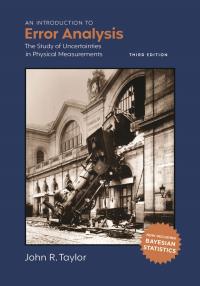An Introduction to Error Analysis
An Introduction to Error Analysis
By: John R. Taylor
John R. Taylor’s best-selling text has now been released in a new third edition that features Bayesian statistics and updated new chapter-ending problems throughout. Previously translated into nine languages, this brilliant little text introduces the study of uncertainties to lower division science students using familiar examples.
For all sales outside of the United States, please contact Felicity Henson, fhenson@aip.org
Title information
This remarkable text by John R. Taylor has been a non-stop best-selling international hit since it was first published forty years ago. However, the two-plus decades since the second edition was released have seen two dramatic developments; the huge rise in popularity of Bayesian statistics, and the continued increase in the power and availability of computers and calculators. In response to the former, Taylor has added a full chapter dedicated to Bayesian thinking, introducing conditional probabilities and Bayes’ theorem. The several examples presented in the new third edition are intentionally very simple, designed to give readers a clear understanding of what Bayesian statistics is all about as their first step on a journey to become practicing Bayesians. In response to the second development, Taylor has added a number of chapter-ending problems that will encourage readers to learn how to solve problems using computers. While many of these can be solved using programs such as Matlab or Mathematica, almost all of them are stated to apply to commonly available spreadsheet programs like Microsoft Excel. These programs provide a convenient way to record and process data and to calculate quantities like standard deviations, correlation coefficients, and normal distributions; they also have the wonderful ability – if students construct their own spreadsheets and avoid the temptation to use built-in functions – to teach the meaning of these concepts.
Preface to the Third Edition
Part I.
Chapter 1. Preliminary Description of Error Analysis
Chapter 2. How to Report and Use Uncertainties
Chapter 3. Propagation of Uncertainties
Chapter 4. Statistical Analysis of Random Uncertainties
Chapter 5. The Normal Distribution
Part II.
Chapter 6. Rejection of Data
Chapter 7. Weighted Averages
Chapter 8. Least-Square Fitting
Chapter 9. Covariance and Correlation
Chapter 10. The Binomial Distribution
Chapter 11. The Poisson Distribution
Chapter 12. The Chi-Squared Test for a Distribution
Chapter 13. Bayesian Statistics
Appendix A. Normal Error Integral, I
Appendix B. Normal Error Integral, II
Appendix C. Probabilities for Correlation Coefficients
Appendix D. Probabilities for Chi Squared
Appendix E. Two Proofs Concerning Sample Standard Deviations
|
“The new chapter on Bayesian statistics is extremely clear and well written, and is another one of John Taylor’s fabulous expositions. I enjoyed how Taylor develops the subject by using it to answer questions about the effectiveness of a vaccine. Before reading this chapter I wondered what assumptions are needed to derive a numerical value for a vaccine’s effectiveness, and I also wondered about the data needed and the methods used. Lo and behold, all my questions were answered in this chapter! I definitely will buy the new edition of Error Analysis and I look forward to delving into the Bayesian statistics.” -Mark Semon, Bates College From the Second Edition “This text provides a rational, step-by-step introduction to understanding and estimating random uncertainties in physical measurements. Although the text is intended primarily for undergraduate students, I find it useful as well at the research level, to introduce graduate students to unfamiliar topics in the study of experimental uncertainties…a high-quality resource [students] can continue to learn from, even after they graduate.” -Physics Today “Score a hit! The book reveals the exceptional skill of the author as lecturer and teacher. A valuable reference work for any student (or instructor) in the sciences and engineering.” -The Physics Teacher |
John R. Taylor
John R. Taylor is Emeritus Professor of Physics and Presidential Teaching Scholar at the University of Colorado at Boulder. He received his B.A. in mathematics from Cambridge University and his Ph.D. in physics from the University of California at Berkeley. In 1966, he joined the faculty at Colorado, where his research interests include quantum scattering theory and the foundations of quantum theory. Professor Taylor has won numerous teaching awards, served as Associate Editor of the American Journal of Physics, received an Emmy Award for his television series called “Physics 4 Fun,” and given “Mr. Wizard” lectures to some 40,000 school children throughout Colorado. He has written three internationally best-selling textbooks, including the landmark Classical Mechanics, Introduction to Error Analysis, and Modern Physics for Scientists and Engineers.

